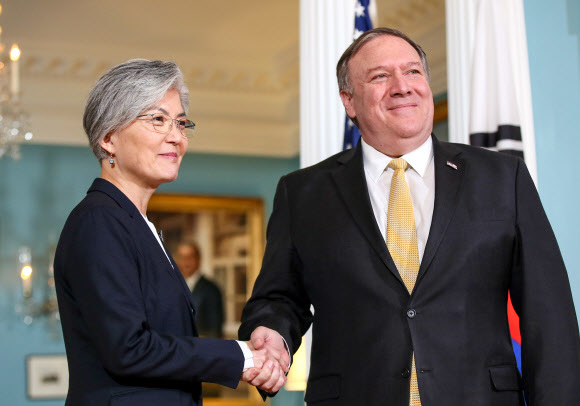 |
|
South Korean Foreign Minister Kang Kyung-wha and US Secretary of State Mike Pompeo in Washington, DC, on Mar. 29. (Yonhap News)
|
Kang Kyung-wha and Pompeo meet in Washington and discuss “post-Hanoi” cooperation
South Korea and the US are moving forward with coordinating the summit between South Korean President Moon Jae-in and US President Donald Trump that’s scheduled for Apr. 11. Following a meeting between South Korean Foreign Minister Kang Kyung-wha and US Secretary of State Mike Pompeo in Washington, DC, on Mar. 29, when the two top diploamts discussed methods of “post-Hanoi” cooperation, Kim Hyun-chong, second deputy chief of South Korea’s National Security Office, arrived in the US on Mar. 30 and is planning to meet with White House Deputy National Security Advisor Charles Kupperman on Apr. 1 to coordinate the agenda of the South Korea-US summit. The arrival of April coincides with a frenzied effort to salvage North Korea-US dialogue, which is at an impasse. The first thing to watch for at the South Korea-US summit – which will be held some 40 days after the North Korea-US summit in Hanoi concluded without an agreement – is what approach will be devised for restarting North Korea-US dialogue. Seoul is aiming for an overarching framework consisting of a comprehensive agreement and step-by-step implementation. Under this vision, North Korea and the US would first agree on how they define denuclearization, what the final stage will look like and how they will get there and then move toward that goal in stages along with corresponding measures from the US. Resuming Kaesong Complex operations and Mt. Kumgang tourism? The initial incentives being discussed to persuade North Korea to sign on to that plan are resuming operations at the Kaesong Complex and tourism to Mt. Kumgang. On Mar. 29, a high-ranking official in the South Korean government told reporters that “the US fully understands the necessity of continuing to implement inter-Korean agreements as well as South Korea’s determination to do so.” This official added that the issues of the Kaesong Complex and tourism to Mt. Kumgang had been “comprehensively discussed” during Kang and Pompeo’s meeting but that “they didn’t get into the specifics.” Since the Kaesong Complex and Mt. Kumgang are matters in which North Korean leader Kim Jong-un has taken interest, mentioning their “unconditional reopening” during his New Year’s speech early this year, they are regarded as key incentives for convincing North Korea to take steps toward denuclearization. Another approach that’s receiving a lot of attention is the “snapback” clause, which refers to relaxing sanctions on North Korea with the understanding that those sanctions would be reinstated if the North fails to implement its promise to denuclearize. North Korean Vice Foreign Minister Choe Son-hui recently referred to the snapback, saying that Trump had been open to the idea during the Hanoi summit. Choe’s reference is being taken to mean that North Korea is also quite interested in the snapback. When reporters asked Kim Hyun-chong on Mar. 30 whether he would be deliberating the snapback issue while in the US, he declined to comment. Seoul is also stressing the need for Kim and Trump to maintain their “top-down” approach as they have thus far in the North Korea-US dialogue. This emphasis reflects the desire to maintain the momentum of dialogue and minimize the threat posed by the growing influence of hardliners inside the US administration. “The reason we’ve made it this far is because of the top-down approach. It’s important for dialogue to be kept on its present course through that approach,” Kim Hyun-chong said. Trump has also continued to make friendly overtures to North Korea. When asked on Mar. 29 why he’d recently ordered the cancellation of additional sanctions against the North on Twitter, Trump said, “[Kim and I] understand each other. [. . .] I think it’s very important that you maintain that relationship at least as long as you can.” “They are suffering greatly in North Korea. [. . .] And I didn’t think additional sanctions at this time were necessary,” Trump also said. Possibility of inter-Korean high-level meeting before Apr. 11 summit Another looming question is whether Moon will try to verify Kim’s assessment of the situation and his message to the US before his summit with Trump. When Kim Hyun-chong was asked whether Moon is planning to send a special envoy to the North prior to the South Korea-US summit, he said, “You’re talking about sequencing, but I think it’s also a good idea to coordinate things with our American allies before that meeting.” This is taken to mean that, for the moment, Seoul is planning to coordinate matters with the US before moving on to inter-Korean dialogue. But there is still a possibility of contact between high-level officials from South and North Korea prior to Apr. 11. By Hwang Joon-bum, Washington correspondent Please direct comments or questions to [english@hani.co.kr]






